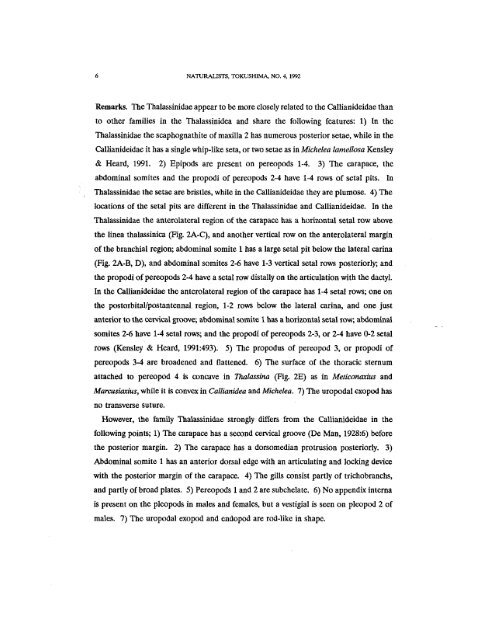Les Thalassinidea (Crustacea, Decapoda) du ... - AToL Decapoda
Les Thalassinidea (Crustacea, Decapoda) du ... - AToL Decapoda
Les Thalassinidea (Crustacea, Decapoda) du ... - AToL Decapoda
You also want an ePaper? Increase the reach of your titles
YUMPU automatically turns print PDFs into web optimized ePapers that Google loves.
6 NATURALISTS, TOKUSHIMA, NO. 4, 1992<br />
Remarks. The Thalassinidae appear to be more closely related to the Callianideidae than<br />
to other families in the <strong>Thalassinidea</strong> and share the following features: 1) In the<br />
Thalassinidae the scaphognathite of maxilla 2 has numerous posterior setae, while in the<br />
Callianideidae it has a single whip-like seta, or two setae as in Michelea lamellosa Kensley<br />
& Heard, 1991. 2) Epipods are present on pereopods 1-4. 3) The carapace, the<br />
abdominal somites and the propodi of pereopods 2-4 have 1-4 rows of setal pits. In<br />
Thalassinidae the setae are bristles, while in the Callianideidae they are plumose. 4) The<br />
locations of the setal pits are different in the Thalassinidae and Callianideidae. In the<br />
Thalas&inidae the anterolateral region of the carapace has a horizontal setal row above<br />
the linea thalassinica (Fig. 2A-C), and another vertical row on the anterolateral margin<br />
of the branchial region; abdominal somite 1 has a large setal pit below the lateral carina<br />
(Fig. 2A-B, D), and abdominal somites 2-6 have 1-3 vertical setal rows posteriorly; and<br />
the propodi of pereopods 2-4 have a setal row distally on the articulation with the dactyl.<br />
In the Callianideidae the anterolateral region of the carapace has 1-4 setal rows; one on<br />
the postorbital/postantennal region, 1-2 rows below the lateral carina, and one just<br />
anterior to the cervical groove; abdominal somite 1 has a horizontal setal row; abdominal<br />
somites 2-6 have 1-4 setal rows; and the propodi of pereopods 2-3, or 2-4 have 0-2 setal<br />
rows (Kensley & Heard, 1991:493). 5) The propo<strong>du</strong>s of pereopod 3, or propodi of<br />
pereopods 3-4 are broadened and flattened, 6) The surface of the thoracic sternum<br />
attached to pereopod 4 is concave in Thalassina (Fig. 2E) as in Mettconaxius and<br />
Marcusiaxius, while it is convex in Callianidea and Michelea, 7) The uropodal exopod has<br />
no transverse suture.<br />
However, the family Thalassinidae strongly differs from the Callianideidae in the<br />
following points; 1) The carapace has a second cervical groove (De Man, 1928:6) before<br />
the posterior margin. 2) The carapace has a dorsomedian protrusion posteriorly. 3)<br />
Abdominal somite 1 has an anterior dorsal edge with an articulating and locking device<br />
with the posterior margin of the carapace. 4) The gills consist partly of trichobranchs,<br />
and partly of broad plates. 5) Pereopods 1 and 2 are subchelate. 6) No appendix interna<br />
is present on the pleopods in males and females, but a vestigial is seen on pleopod 2 of<br />
males. 7) Tlie uropodal exopod and endopod are rod-like in shape.

















